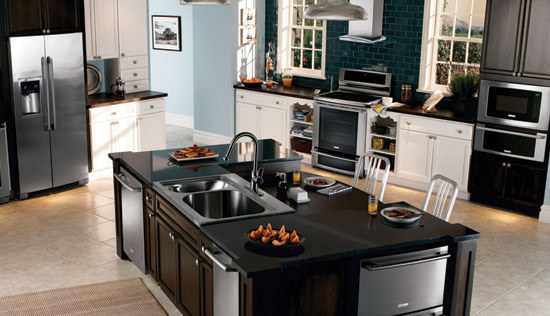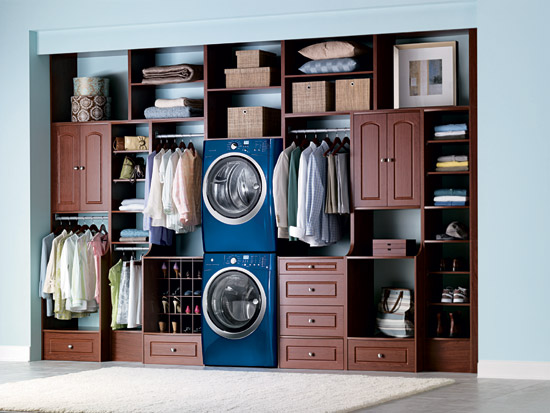Using Built-in Appliances to Enhance Design
Let's look first at the work area for receiving and storing food. The common functional elements here include cabinetry or pantry type storage for keeping food at room temperature. For perishable food that must be kept cool or frozen to be stored, the main appliance is the refrigerator/freezer. In all cases, planning for the right quantity of food storage is important for both perishable and non-perishable foods. The determining factor here is the size of the household and occupant lifestyle. A single person or working couple that eats out often likely has very different food storage needs than a large family with a vegetable garden in the back yard. Allowing for adequate refrigerated storage as well as room temperature storage, perhaps with some flexibility to add more as needs change, is a basic first step in kitchen planning.
Next, the work area for food cleaning and preparation comes into play. A work surface near the food storage area is useful for unpacking, cutting, mixing, or otherwise processing food. But quite importantly, a sink is needed for cleaning, rinsing, or draining during the food preparation process or for adding water when recipes call for it. Although a small dedicated food prep sink is sometimes used in larger kitchen layouts, it is more common that one sink is used for all cleaning and washing that take place in the kitchen. This means that washing of pots, pans, dishes, etc. will likely occur here and appliances such as a dishwasher and disposal will be logically located in this work area as well.
 |
Kitchen planning principles identify three functional areas that work in concert with each other, the refrigerator area, the cooking area, and the sink area. Photo courtesy of Electrolux |
With the food taken from storage and appropriately prepared, it is now ready for cooking and serving. This third functional work area is extremely appliance centered with a diversity of choices in the type of cooking that can be done. Stove or range-top cooking is a time-honored tradition but can also include indoor griddle or grilling options. Ovens can be conventional or use convection fans to speed cooking times. And the ubiquitous symbol of modern busy lifestyles, the microwave oven needs to fit in somewhere appropriate to this work area. During and after cooking, adjacent work surfaces are needed to accommodate the addition of ingredients, place utensils or serving dishes, and generally support the cooking function of the appliances.
These three fundamental kitchen work areas, often appropriately referred to as the refrigerator area, the sink area, and the cooking area, together form the basis of a successful modern kitchen design. However, it is obviously critical that the three of them work together, are balanced in location, and each sized appropriately to their anticipated use. Since the sink area often supports the functions of the other two areas, it is typically located between them. The refrigerator area is often located near the entry to the kitchen to facilitate food storage while the cooking center is often located closer to the dining area to facilitate serving. Of course, there are reasons for variations to these typical conditions, some of which may include the addition of other work centers such as freestanding work islands or remote serving/staging areas. In all cases, however, the fundamental principle of the “work triangle” should be considered. Essentially, this approach acknowledges that a person working in a residential kitchen likely spends a good deal of time moving between the three core work areas, and more specifically, between the refrigerator, the sink, and the cooking appliances. Keeping the number of steps (i.e. the distance) between those three a minimum number means efficiency is increased. Spreading them out too far creates a need for unnecessary walking, poor workflow, and usually unhappy clients.
Laundry Design Principles
The primary functions of a laundry area are to wash and dry clothes. Additionally, it may also include pre-washing in a sink, sorting, ironing, and folding of clothes. Allowing space for all of these activities is important and either needs to occur directly adjacent to the washing and drying appliances or in another appropriate place. The workflow of the room or area should account for these various functions and the order in which they normally occur.
Beyond the working functions of the laundry area, its location in relation to the rest of the house and living spaces is significant. While locating the laundry in the basement or an entry area near the garage has been done for decades, it is clearly not the most convenient place for it to be located since clothes likely will need to be carried to and from there. A case is often made for locating the laundry on the main floor, often near the kitchen where the people in the residence can readily access it during the regular course of a day. Of course that still means that clothes may need to be carried up or down stairs and space needs to be allocated for sorting, folding, etc. Others advocate for it to be located logically near the place where most of the clothes are kept—the dressing areas of the house or bedrooms. In some cases, putting the washer and dryer right in the main dressing room could be logical, particularly if there are only one or two people living in the residence. In all cases, the role of the designer is paramount in determining how to best integrate the functions and appliances of the laundry with the form of the full residence.
 |
Laundry appliances can be integrated wherever they are the most useful, consistent with occupant lifestyles. Photo courtesy of Electrolux |
Kitchen Design Enhanced by Appliances
With a basic understanding of the driving design principles in kitchens and laundry areas, let's turn our attention to some of the key components of each—namely the appliances which dominate the attention of those using these spaces. We will start with kitchen appliances which enhance specific functions in all residential kitchens whether in new construction or renovation, single family or multifamily housing.
One of the distinctions to make right off the bat is the difference between appliances that appear to be “freestanding” and those that are “built-in.” The reality is that all appliances are separate, manufactured products that are installed into a kitchen. The distinction is whether or not they are secured in place to cabinetry or walls and trimmed out to look “built-in.” If so, then they are usually much more visually integrated and consistent with the design of the kitchen. In some cases, door panels on appliances can be customized to match the appearance of surrounding cabinetry or finishes while in other cases it may be advantageous to retain the look of finished metal such as stainless steel. Obviously there are distinctions in the way that appliances are made to accommodate the “built-in” appearance but there are also usually more choices in sizes, features, and options than for those that are easily disconnected and appear less visually integrated into a space.









